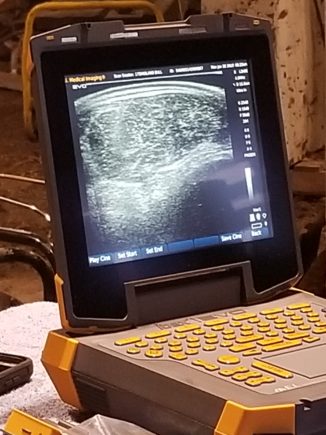Ultrasound & Fertility Testing
Ultrasound
Over the last few decades, Midland has collected as much if not more ultrasound data than just about any other location in the country.
All test bulls are evaluated by ultrasound so that a complete comparison can be made amongst all the bulls on trial. Collection of ultrasound data is done in accordance with the guidelines developed by the Ultrasound Governance Committee, which oversees ultrasound matters for the U. S. Beef Breeds Council. The images collected are submitted to UltraInsights, a centralized ultrasound processing lab. All bulls enrolled in their respective breed association’s performance program have data submitted to the breed association so that the ultrasound data is incorporated into the genetic evaluation for the breeder. In that way, the most accurate EPDs are available for the bulls prior to the sale. Carcass EPD’s reflective of the data collected will be in the sale catalog. A full report is available by request.
Fertility Testing
A major objective in a cow-calf operations is to produce one calf from each cow annually. The degree to which producers meet this goal influences their net income. A key component of efficient calf production is a high fertility level in each breeding animal in the herd. Since individual bulls service many females, a deficiency in the breeding ability of one bull has a larger impact on herd productivity than fertility problems in a single female. Using a subfertile bull may lead to longer calving intervals, a lower number of calves produced and increased costs from wintering open females. All of these results cause serious economic loss to the cow-calf producer.
It is not feasible to determine true fertility before a bull is used in the herd. Nevertheless, a bull can be evaluated for breeding soundness to assess his potential fertility. A few bulls may be sterile, but most have fertility levels ranging from very high to very low. At Midland, all sale bulls have passed a thorough breeding soundness exam (BSE) including extension, motility and morphology.
Scrotal Circumference
All sale bulls must adjust to a minimum of 32 cm testicle size at 365 days of age (unless specified otherwise by the respective breed association).
Measuring the scrotal circumference of young bulls is an accurate, repeatable method to assess current and future sperm-producing ability. The measurement gives an estimate of the weight of the testes, which is directly related to the level of sperm production. Scrotal measurement is also positively correlated with semen volume and quality. Bulls with adequate scrotal development for their age have a higher probability of becoming satisfactory breeders than bulls with smaller scrotal circumferences. Scrotal circumference is of medium to high heritability. Fertility of the male offspring can be increased by selection for this trait. The scrotal circumference of a bull is also positively related to the fertility of his daughters. Heifers from sires with larger than average scrotal circumference tend to reach puberty earlier than those from bulls with smaller scrotal circumferences. Increased scrotal circumference in sires is also favorably correlated to their daughter’s age at first breeding, pregnancy rate and days to rebreeding after calving.
Semen Quality
The criteria commonly used to evaluate semen quality include sperm morphology (structure) and motility (rate and percent of progressive forward movement). Semen volume and concentration will also be used.
